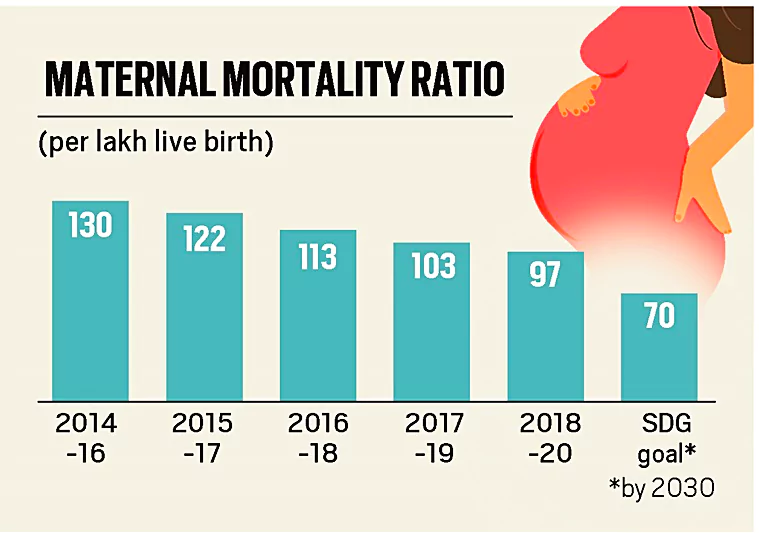Context
Indian Council of Medical Research (ICMR) to fund a study to analyze the number of maternal deaths related to heart diseases and to develop a treatment protocol to prevent future mortality.
ICMR Study On Heart Disease

The ICMR study will be held across 50 centres across India to be representative of the Indian population with 7 AIIMS also participating.
- Objective: To identify the 10 most common heart diseases in pregnant women and to also develop their treatment protocol that can be accessed in remote rural pockets.
- Budget: The study will cost an estimated 8 crores.
Heart Disease Related Maternal Deaths in India
Metabolic changes due to Pregnancy: As per a Lancet study, the risk of heart failure in a mother increases steadily by 24 weeks, plateaus at 30 weeks and peaks again around delivery with significant cardiovascular changes happening in the mother within the first eight weeks of pregnancy.
Enroll now for UPSC Online Course
- Common Cause: A study of the trial data from 2016 to 2019 in Tamil Nadu has found that valvular heart diseases (conditions in which the heart valves do not function normally) makes up around two-thirds (66.66%) of the heart disease related maternal deaths.
- Congenital heart diseases (problems of heart structure present by birth) comprised 33 percent of maternal deaths.
- Concern:
- Undiagnosed Heart related Issues: As per a study, 60 percent of the women came to know of a heart disease (congenital heart disease) that is diagnosed for the first time during their pregnancy.
- Societal Stigma: In some cases parents hide the diseased condition due to problems in getting married. And, when they do get married they face complications sometimes resulting in death.
- Lack of cardio-obstetrics teams in hospitals: Cardiologists and obstetricians need to work together which often gets ignored because it is managed by two different specialties to bring down maternal deaths caused by heart disease.
Maternal Mortality Ratio (MMR)
Maternal Mortality Ratio (MMR) is the number of maternal deaths during a given time period per 100,000 live births during the same time period.
- It is the annual number of female deaths from any cause related to or aggravated by pregnancy or its management (excluding accidental or incidental causes) during pregnancy and childbirth or within 42 days of termination of pregnancy per 100,000 live births.
- India MMR Ratio: As per Government data, India reported a MMR of 97 deaths per lakh live births between 2018 and 2020, achieving the target set by The National Health Policy (NHP) 2017 of MMR in India below 100/lakh live births by 2020.
- India’s MMR has gone down by 70 per cent, with an MMR of 556 in 1990 to 103 in 2017.
- SDG Target 3.1: To reduce global MMR to less than 70 per 100 000 live births by 2030.
- WHO leads the UN Maternal Mortality Estimation Interagency Group (MMEIG) composed of WHO, UNICEF, UNFPA, the United Nations Population Division, and the World Bank Group
- Indian States that have achieved SDG target: Kerala (19), Maharashtra (33), Telangana (43), Andhra Pradesh (45), Tamil Nadu (54), Jharkhand (56), Gujarat (57), Karnataka (69)
- Leading cause of MMR : They are haemorrhage or uncontrolled bleeding (47 per cent), pregnancy-related infection (12 per cent), and hypertensive disorders of pregnancy (seven per cent).
Government Initiatives to Reduce Maternal Mortality Ratio (MMR)
Here are some government initiatives to reduce the maternal mortality ratio (MMR) in India:
- Pradhan Mantri Surakshit Matritva Abhiyan: To improve the quality and coverage of diagnostics and counseling services, along with providing assured comprehensive and quality antenatal care free of cost.
- POSHAN Abhiyaan: Pregnant Women are one of the key target groups of the government’s flagship programme to improve nutritional outcomes.
- Pradhan Mantri Matru Vandana Yojana (PMMVY): It is a direct benefit transfer (DBT) scheme under which cash benefits are provided to pregnant women in their bank account directly to meet enhanced nutritional needs and partially compensate for wage loss.
- Surakshit Matritva Anushasan (SUMAN): It aims to provide assured, dignified and respectful delivery of quality healthcare services at no cost and zero tolerance of denial of services to any women and newborn in any public health facility.
- Labour Room & Quality Improvement Initiative (LaQshya): Providing a positive birthing experience to pregnant women by improving the quality of care in labor room, maternity Operation Theatre and Obstetrics Intensive Care Units (ICUs) & High Dependency Units (HDUs)
- Rise in Institutional deliveries: Institutional deliveries in India have increased to 89 per cent in 2019-20 with around 87% births in rural areas and 94% births in urban areas.
- Steps to promote institutional deliveries: operationalisation of Sub-Centres, Primary Health Centres, Community Health Centres and District Hospitals for providing 24×7 basic and comprehensive obstetric care.
- Training in obstetric care: Capacity building of healthcare providers in basic and comprehensive obstetric care to enable them to provide high quality services during childbirth.
|
![]() 18 Apr 2024
18 Apr 2024

